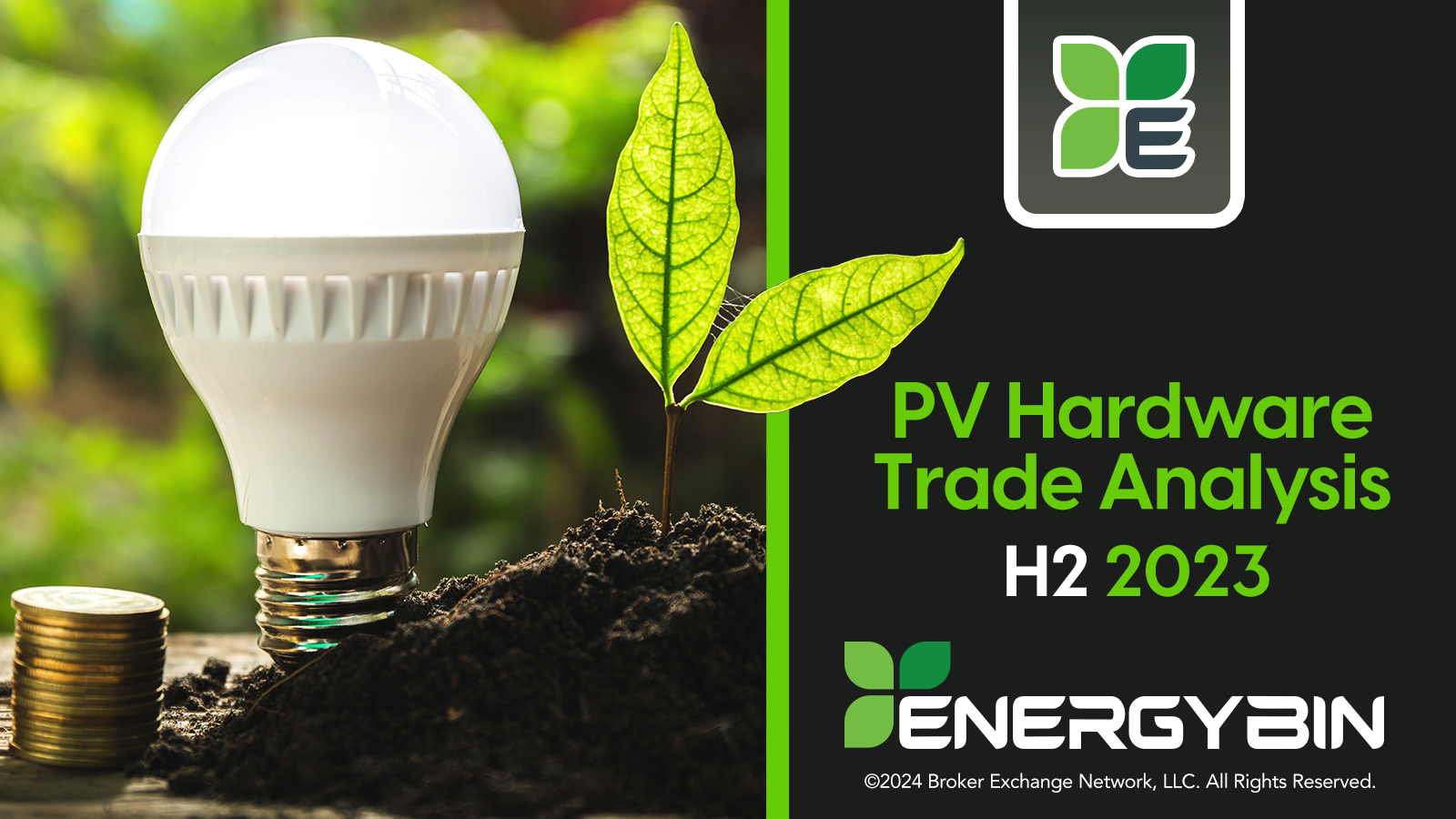About the report
The purpose of this report is to provide a sample of the market intelligence available via PV hardware trade activity on the EnergyBin exchange platform. Our goal is to contribute data to the solar industry that can be used to help make informed decisions about equipment trade.
This report analyzes data based on the following activities:
- Common reasons for buying and selling
- Product categories listed for sale
- Requests to buy products
- Major brands listed by sellers and requested by buyers
- Module availability
- Module pricing
The report timeline represents site activity from the second half of the 2023 year (H2 2023). It compares findings from EnergyBin’s 2023 PV Module Price Index Report for c-Si module pricing and availability.
Join EnergyBin to access all data and customize data that’s relevant to your business goals.
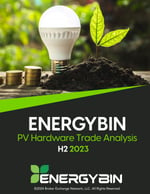 Download the PDF version of the PV Hardware Trade Analysis.
Download the PDF version of the PV Hardware Trade Analysis.
Key Findings
1. Modules represented 58 percent of the total PV hardware for sale on the EnergyBin trading exchange followed by inverters at 16 percent, electrical BOS components at 13 percent, and structural BOS components at 4 percent.
2. ESS products for sale increased by 10 percent from H1 to H2 2023. The share of ESS products compared to the total PV hardware for sale increased from 6 percent in H1 to 8 percent in H2.
3. Modules represented 64 percent of the total buying inquiries on EnergyBin followed by inverters at 29 percent, and electrical BOS components at 4 percent.
4. 41 percent of buying inquiries were submitted for the purpose of sourcing hardware for new projects.
5. Nearly half of the buying inquiries noted the reason to buy as either looking for replacement parts (37 percent) or adding onto existing PV systems (10 percent).
6. The number of buying inquiries attributed to finding replacement parts increased by 38 percent from H1 2023. Requests for hardware to add onto existing systems rose by 36 percent. These upward trends point to a growing desire to extend the lifespan of PV systems.
7. The most common module brands in sales listings and buying inquiries were Canadian Solar, QCELLS, Silfab, LG, Aptos, ZnShine, Trina Solar, and Haitai. The most common inverter brands were SMA, Fronius, SolarEdge, Enphase, and TIGO.
8. Module prices across all technology classes decreased since H1 2023 to prices at or below 2019 levels. At the close of Q4 2023, All Black and High Efficiency modules were listing as low as $0.19-0.22/Wp, and Mainstream modules were as low as $0.14/Wp.
9. PV module supply listed for sale on EnergyBin increased by 29 percent since 2020. The vast majority (93 percent) were new modules. Over 80 percent had efficiency rates of 19.0 percent or higher.
10. The volume of Used modules increased by 282 percent since 2020, which indicates a growing reuse market.
About EnergyBin
EnergyBin is a global exchange for PV professionals to connect, access market intelligence, and buy & sell wholesale solar equipment.
The PV professionals who make up EnergyBin’s membership represent the industry’s downstream supply chain from manufacturers to lifecycle solutions providers (resellers, repair, remanufacturers, recyclers, etc.). Members oversee projects in the residential, commercial, agricultural, industrial, and small-scale utility markets.
Of the nearly 1,000 members, the largest business category is installers and contractors (36 percent) followed by distributors and suppliers (22 percent). Additionally, 7 percent are manufacturers, 9 percent are EPCs, 10 percent are brokers, 4 percent are operations & maintenance technicians, 5 percent are developers and utilities, including independent power providers, and 7 percent are specialized service providers (recyclers, logistics, finance, insurance, 3rd party warranty providers, software companies, etc.).
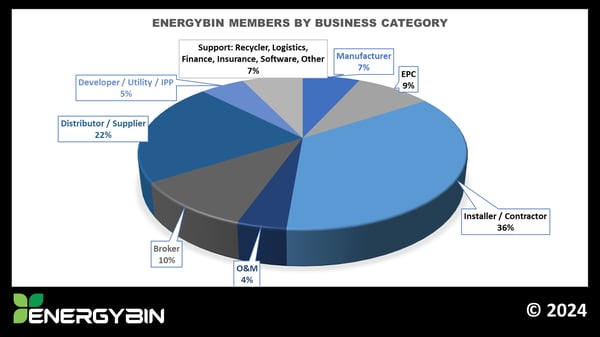
Common reasons to buy and sell on EnergyBin
PV hardware traded on EnergyBin is considered to be secondary market goods. The secondary market should not be thought of as a ‘secondhand’ market; although, some goods traded may have been previously installed in a solar system.
Rather, the secondary market consists of both new and used equipment. It brings together buyers and sellers to trade commodities that have previously been issued or introduced into the primary market to offer an alternative channel for the following scenarios:
- Remarketed products that primary buyers aren’t purchasing, including clearance, close-outs, surplus, and miscellaneous one-offs
- Asset liquidations from company acquisitions and bankruptcies
- Leftover products (new with warranty, yet never installed) from bulk purchases and project installations
- Products for resale (new with warranty, yet never installed) resulting from project cancellations, project delays, and downsized projects
- Products for resale that are used, refurbished, or remanufactured and have no manufacturer warranty, but possibly have an assigned 3rd party warranty and/or service warranty.
Sellers
Wholesale sellers on EnergyBin primarily seek to connect with pre-qualified buyers. Many desire to form lasting relationships with buyers who need large-volume quantities. They also come to access information on competitors’ pricing and product availability. Some aim to introduce products to new markets. Sellers tend to take on one of the following business models.
Merchant or Stocking Wholesaler
Merchant wholesalers take title of the inventory. They may have multiple warehouses or one central storage facility. They stock many SKUs and brands.
Distributor
Distributors are like merchant wholesalers except for one major difference. They choose to only represent a select number of brands. Distributors prefer to stock top brand names from manufacturers who have a stable track record and established bankability.
Agent Wholesaler
Agent wholesalers don’t take ownership of the inventory but rather represent manufacturers and other sellers. They facilitate transactions, including taking orders, negotiating contracts, scheduling delivery, and collecting payment.
Reseller
A wholesale reseller is unique in the sense that they don’t always follow a traditional vertical supply chain. Rather, they tend to acquire goods from a variety of supplier relationships like manufacturers, other wholesalers, liquidators, auction houses, and even developers, EPCs and contractors with excess and second-hand material. They may work with solar equipment brokers to buy and sell goods as well.
Additionally, sellers join EnergyBin to promote their value-added services. Some provide storage space to contractors and will drop ship equipment to project worksites. Some offer lines of credit. And some buy back excess and used equipment if the material has resale value. Several suppliers are dedicated to making wholesale buying possible and accessible to all kinds of installers and resellers, regardless of their size and capacity.
Buyers
Wholesale buyers on EnergyBin come looking for an alternative sourcing solution. They seek to efficiently request price quotes from multiple vetted sellers. Many want access to bulk order discounts. Several need to locate hardware that their primary vendors either don’t carry or don’t have in stock. Others search EnergyBin for replacement parts and repair services. Some want to connect to recycling partners. Buyers who act as resellers to consumers aim to buy low on EnergyBin.
Buyers = Sellers
As you review the report findings, don’t presume that a member of EnergyBin is only a buyer or a seller. The EnergyBin platform exists to support wholesale solar equipment brokering. This means that you can buy and sell based on your customers’ needs, which often change from one day to the next.
For example, a supplier who joins EnergyBin with the intention to sell may also take on a buying role for a customer in need of replacement modules or inverters that the supplier no longer stocks.
Or, an installer who joins EnergyBin to primarily buy equipment at reduced pricing may have leftover equipment from a project that they then list for resale on the exchange. Furthermore, an installer may have a customer with an existing solar array who decides to upgrade their technology. The installer handles the decommissioning, determines that the used modules have resale value, and remarkets them on EnergyBin.
These scenarios are just a few opportunities that we observe EnergyBin members actively pursuing on our exchange.
Product categories for sale
The report analyzed a sample of 1,000 Want-to-Sell (WTS) Broadcasts posted to the EnergyBin platform to determine product category breakdown. Modules represented 58 percent of the total PV hardware for sale followed by inverters at 16 percent and electrical balance-of-system (BOS) components at 13 percent.
Electrical BOS components include optimizers, rapid shutdown devices, cables, wiring, switches, gateways, adaptors, connectors, transformers, monitoring devices, and communications devices. Structural BOS comprises all hardware components related to racking and tracking. Miscellaneous materials for sale on EnergyBin ranged from drones to a mobile solar power wagon to a solar hexagon flower unit.
Energy storage systems (ESS) increased by 10 percent from H1 to H2 2023. The share of ESS products compared to the total PV hardware for sale rose from 6 percent in H1 to 8 percent in H2. As energy storage gains traction in the industry, sellers are beginning to list new and lightly used ESS products for sale on EnergyBin. Most of the listings in the sample were for residential and commercial storage products. Brands included Tesla, QCELLS, Franklin WH, Panasonic, Generac, EnerSys, LG Chem, TIGO, and Sonnen.
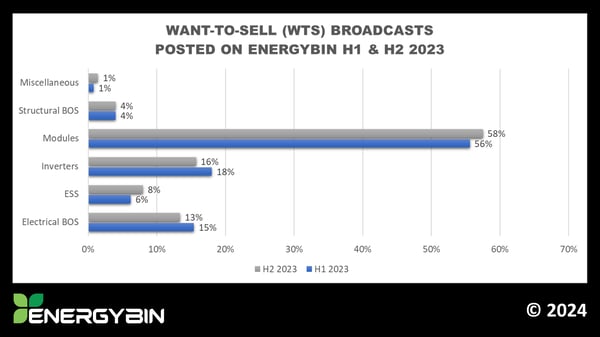
Requests to buy products
The report analyzed a sample of 300 Want-to-Buy (WTB) Broadcasts posted to the EnergyBin platform to assess buyer needs by product category breakdown. Like sales posts, requests for modules represented the largest category at 64 percent followed by inverters at 29 percent.
Note that it’s common for buyers to conduct searches on the platform and contact sellers directly rather than posting a WTB Broadcast. Therefore, it should not be assumed that there are fewer buyers than sellers on EnergyBin. Furthermore, many members dually buy and sell on the exchange.
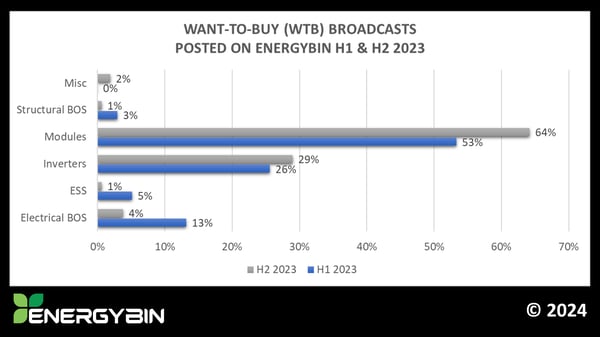
Common Reasons to Buy
Of the total WTB Broadcasts, buying inquiries noted these common reasons to buy:
|
1. |
Hardware for new projects |
41% |
|
2. |
Replacement parts |
37% |
|
3. |
Existing system add-ons |
10% |
|
4. |
Excess / Overstock deals |
8% |
|
5. |
Used hardware for remanufacturing / recycling |
3% |
The number of WTB Broadcasts attributed to finding replacement parts increased by 38 percent from H1 2023. Requests for hardware to add onto existing systems were also up by 36 percent. These upward trends indicate a growing desire to extend the lifespan of PV systems rather than resort to new technology upgrades. Prematurely repowering may not be as feasible to the bottom line nor as friendly to the environment.
Brands in demand
Both sales listings and buying requests shed light on module and inverter brands in demand. Buyers are looking for top quality products and tend to prefer Tier 1 brands. However, nearly 20 percent of WTB posts stated “Any” in the manufacturer field, which means they aren’t always limited to purchasing specific brand names as they are concerned with compatibility.
This is likely related to locating replacement parts, particularly when original brands in older PV systems may no longer be available in the market. To respond to maintenance and operations demand of older systems, some secondary market players have expanded their service offerings to include repair and remanufacturing solutions. As more systems age, these opportunities will increase.
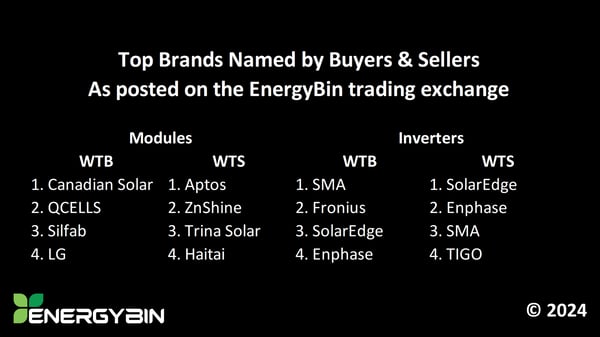
PV module prices by technology
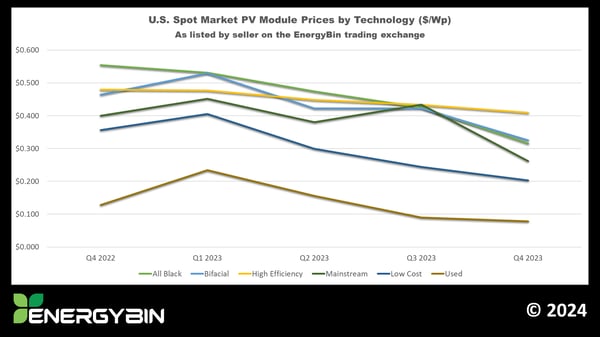
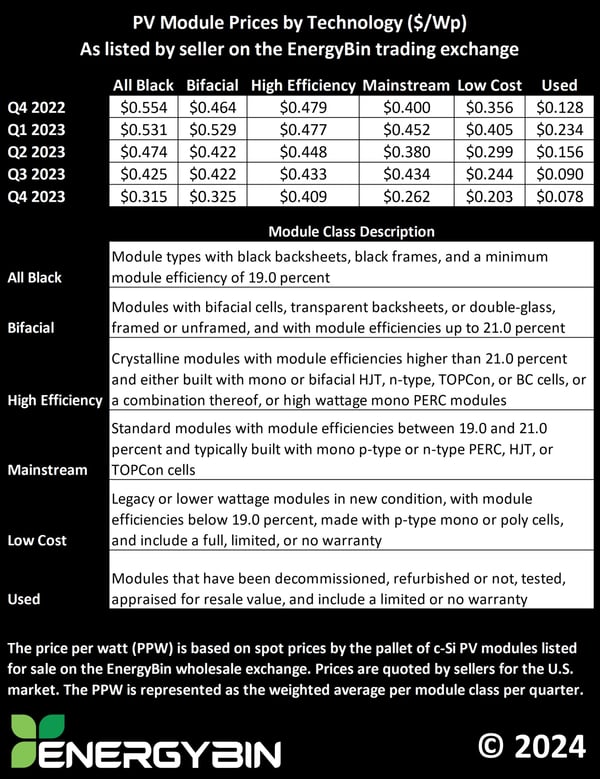
Download the 2023 PV Module Price Index for a more detailed analysis of module prices and supply.
Prices across all module technology classes decreased since H1 2023. This trend is in line with the U.S. spot market, which is currently experiencing the lowest module prices since 2019. At the close of the fourth quarter, prices for All Black and High Efficiency modules were listing as low as $0.19-0.22 per watt, and Mainstream modules were as low as $0.14 per watt.
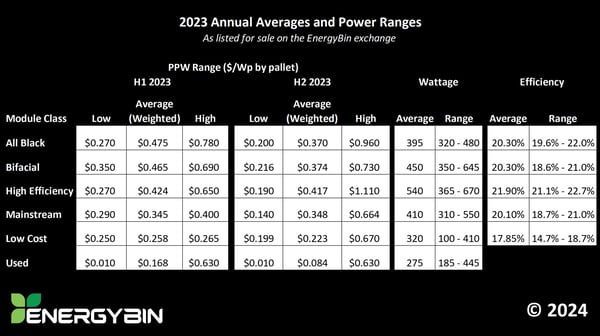
The National Renewable Energy Laboratory (NREL) reported an average U.S. module price of $0.33/Wp for Q3 2023. Although this price was 23 percent lower than the previous year, it was 98 percent higher than the global spot price, suggesting that the U.S. market is better equipped to manage price volatility. U.S. prices will likely remain higher than global prices primarily due to Section 201 tariffs and the U.S. Commerce Department’s final determination on antidumping and countervailing duties, which will take effect in Q3 2024.
On EnergyBin, price ranges were widely skewed for the entirety of 2023. This fluctuation is common within the secondary market and likely correlates to available supply for any given month. As noted in the 2023 PV Module Price Index, “Made in USA” modules listed for resale on the exchange ranged 40-45 percent higher than imports from southeast Asian countries. These listings, as well as discontinued modules like LG, play a role in skewing price ranges.
Regarding Used modules, the average resale value dropped in Q4 to $0.078/Wp as the price per watt for new modules plummeted to about $0.25-0.26/Wp in the U.S. and $0.125/Wp in the global market. In Q1, the average price was $0.168/Wp. This case is a primary example of the effects demand has on Used module resale.
Granted, several factors in addition to demand go into determining resale value, for example, their age, wattage, quantity, condition, and testing performance. Therefore, the spot prices listed in this report should be considered a reference point, not a universal measure. Because no global baseline price exists for used modules, prices remain rather subjective.
PV module availability
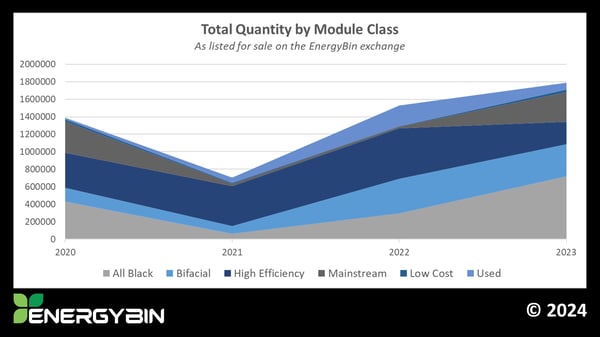
Overall module supply posted for sale on EnergyBin increased by 29 percent since December 2020, an indication that the secondary market is growing. The vast majority (93 percent) were new modules. Over 80 percent had efficiency rates of 19.0 percent or higher.
Used module volume was down 67 percent in 2022 but up 282 percent from 2020. The three-year increase is good news for the solar industry, in which a robust secondary market is necessary to fulfill operations and maintenance needs of existing PV systems, including locating replacement parts and system add-ons. Again, these two scenarios represent nearly half of buying requests made on the EnergyBin exchange in 2023.
If the upward trend in quantity is any indication of what the future holds for the secondary solar market, then we can conclude that it’s well on its way to becoming a robust market supportive of reuse, repair, resale, remanufacturing, and recycling.
Conclusion
The findings in this report support the business case for a robust and sustainable secondary market for PV hardware reuse, resale, and recycling. Using the EnergyBin trading exchange as a gauge for this case, we see a network that is growing in both membership and quantity listed for resale.
Additionally, EnergyBin is a resource for market intelligence with respect to pricing and availability of PV hardware that has fallen out of traditional distribution channels. This report concludes that there is an expanding resale market of both new and used PV hardware.
More Resources
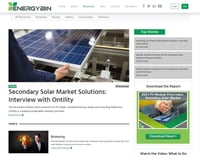 Browse more articles, reports, case studies, and webinar recordings on buying and selling wholesale solar equipment in the secondary market in our Resources portal.
Browse more articles, reports, case studies, and webinar recordings on buying and selling wholesale solar equipment in the secondary market in our Resources portal.
